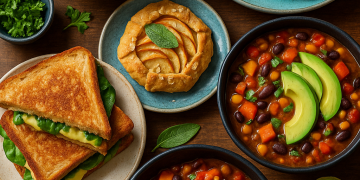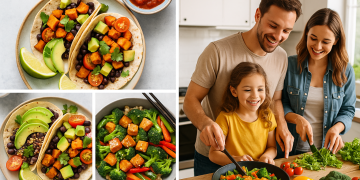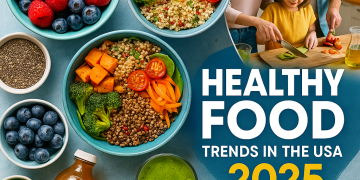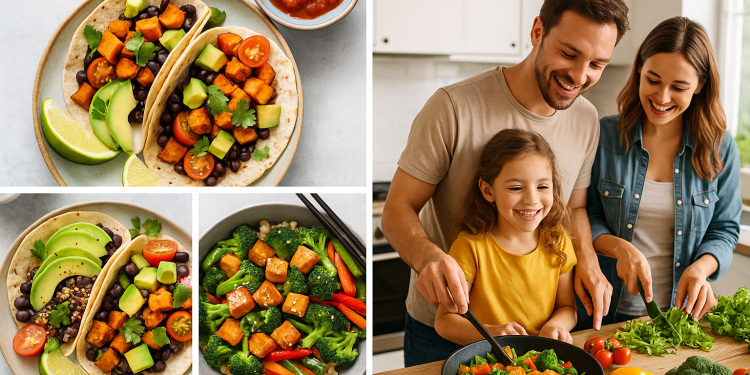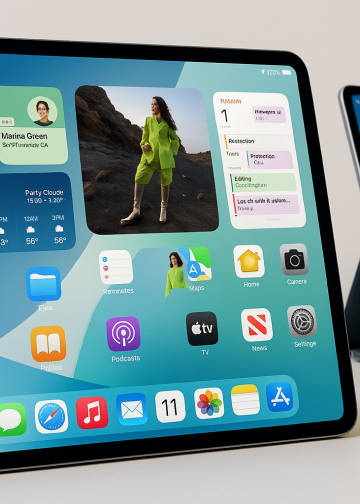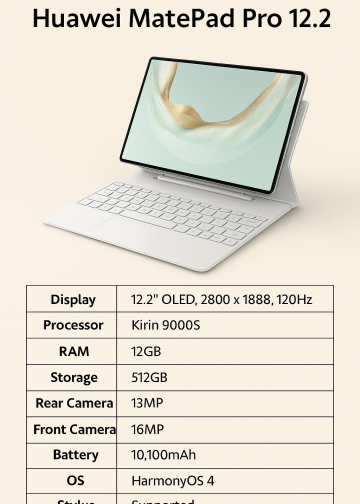Introduction: Why Plant-Based Diets Are Booming in the USA
Step into any grocery store, scroll through social media, or peek at your favorite restaurant’s menu, and you’ll see it: plant-based eating is taking the USA by storm. More Americans than ever are exploring plant-based diets, motivated by health, sustainability, animal welfare, and a hunger for new flavors. Whether you want to go fully vegan, just add more veggies to your plate, or simply discover some delicious recipes, you’re in the right place.
In this guide, we’ll dive into the real benefits of plant-based eating, offer practical tips for American families, and share some of the best vegan recipes to help you build a vibrant, healthy lifestyle—without sacrificing taste or tradition.
1. What Is a Plant-Based Diet?
A plant-based diet focuses on foods from plants: vegetables, fruits, legumes, whole grains, nuts, seeds, and healthy oils. While “plant-based” isn’t always the same as “vegan,” most people use the terms interchangeably.
- Vegan: Excludes all animal products (meat, dairy, eggs, honey).
- Vegetarian: No meat or fish, but may include eggs or dairy.
- Flexitarian: Mostly plant-based, with occasional animal products.
Plant-based diet USA is all about flexibility and choosing more plants, no matter your starting point.
2. Benefits of Plant-Based Eating
2.1. Healthier Heart and Lower Disease Risk
Research consistently shows that people following a plant-based diet have lower rates of heart disease, high blood pressure, and certain cancers. Why? Plants are naturally high in fiber, antioxidants, vitamins, and minerals—and low in cholesterol and saturated fat.
2.2. Better Weight Management
Plant-based eaters often maintain a healthy weight more easily. Thanks to fiber-rich foods, you feel fuller on fewer calories, which helps with appetite control.
2.3. Improved Digestion
A diet high in plants provides prebiotics and fiber, supporting a healthy gut and smoother digestion.
2.4. Reduced Risk of Diabetes
Plant-based eating can lower the risk of type 2 diabetes, and for some people, even help manage or reverse the condition.
2.5. Environmental Impact
One of the biggest benefits of plant-based diets is their low carbon footprint. Producing plants generally uses less water, land, and energy than raising animals, making this diet more sustainable.
2.6. Animal Welfare
By choosing plant-based, you help reduce the demand for factory-farmed animal products, supporting more ethical food systems.
3. Tips for Transitioning to a Plant-Based Diet in the USA
Switching to a plant-based diet USA doesn’t have to be overwhelming! Here are some real-world strategies:
Start Slow
- Begin with “Meatless Mondays” or one plant-based meal per day.
- Try swapping dairy milk for oat or almond milk.
Focus on Addition, Not Subtraction
- Add more veggies, beans, and grains to your current meals before cutting out animal products.
Stock Your Kitchen
- Keep essentials like canned beans, lentils, frozen veggies, whole grains, nuts, and seeds on hand for quick meals.
Try New Recipes
- Explore global cuisines—Mexican, Mediterranean, Indian, and Asian food all offer naturally plant-based options.
Don’t Sweat Perfection
- You don’t have to be 100% vegan to enjoy the benefits of plant-based eating. Every plant-forward choice counts.
4. Common Myths About Plant-Based Diets
Myth: You won’t get enough protein.
Reality: Beans, lentils, tofu, tempeh, quinoa, nuts, and seeds are packed with plant protein.
Myth: It’s too expensive.
Reality: Whole foods like beans, rice, and veggies are often cheaper than meat and processed snacks.
Myth: It’s boring or restrictive.
Reality: The American vegan food scene is exploding with flavor, variety, and creativity.
5. Best American Vegan Food Staples
For anyone adopting a plant-based diet USA, these essentials make healthy eating easy and delicious:
- Beans and lentils: Black beans, chickpeas, kidney beans, and lentils for soups, stews, and salads.
- Whole grains: Brown rice, quinoa, bulgur, barley, and farro.
- Tofu and tempeh: Excellent meat substitutes for stir-fries, grilling, and scrambles.
- Nuts and seeds: Almonds, cashews, chia seeds, flaxseeds, and sunflower seeds for snacks or adding to meals.
- Dark leafy greens: Kale, spinach, collards, and Swiss chard for maximum nutrition.
- Root vegetables: Sweet potatoes, carrots, beets, and turnips are hearty and versatile.
- Plant-based milks: Almond, soy, oat, and cashew milks for smoothies, cereals, and baking.
6. Easy Vegan Recipes for Busy Americans
Let’s get to the good part: food you’ll love! Here are some of the best quick and satisfying vegan recipes that work for busy weeknights or family dinners.
6.1. One-Pot Lentil Chili
- Ingredients: Brown lentils, canned tomatoes, bell peppers, corn, onion, chili powder, cumin, vegetable broth.
- Directions: Sauté veggies, add remaining ingredients, simmer 25 minutes. Serve with avocado and tortilla chips.
6.2. Chickpea Salad Sandwich
- Ingredients: Canned chickpeas, vegan mayo, celery, red onion, lemon juice, salt, pepper.
- Directions: Mash chickpeas and mix everything. Serve on whole grain bread with lettuce and tomato.
6.3. Tofu Stir-Fry
- Ingredients: Firm tofu, broccoli, carrots, snap peas, soy sauce, garlic, ginger, brown rice.
- Directions: Cube and pan-fry tofu. Sauté veggies, add tofu and sauce, serve over rice.
6.4. Sweet Potato Black Bean Tacos
- Ingredients: Roasted sweet potatoes, black beans, corn tortillas, salsa, cilantro.
- Directions: Roast sweet potatoes, heat beans, fill tortillas, top with salsa.
6.5. Creamy Vegan Pasta Primavera
- Ingredients: Whole grain pasta, zucchini, cherry tomatoes, peas, spinach, cashew cream sauce.
- Directions: Sauté veggies, cook pasta, toss with sauce.
7. Table: Simple Plant-Based Meal Plan for a Week
| Day | Breakfast | Lunch | Dinner |
|---|---|---|---|
| Monday | Oatmeal w/ berries | Chickpea salad sandwich | Lentil chili |
| Tuesday | Smoothie bowl | Veggie wrap | Tofu stir-fry |
| Wednesday | Peanut butter toast | Quinoa salad | Sweet potato tacos |
| Thursday | Chia pudding | Black bean burrito bowl | Vegan pasta primavera |
| Friday | Avocado toast | Hummus and veggie sandwich | Vegetable curry with rice |
| Saturday | Pancakes (plant milk) | Leftovers or salad | Stuffed bell peppers |
| Sunday | Fruit & granola | Noodle bowl | Grilled veggie skewers |
8. Eating Plant-Based on the Go: Tips for Dining Out
- Research ahead: Most restaurants offer vegan/vegetarian options or will make substitutions.
- Look for cuisines: Mexican, Thai, Indian, and Mediterranean spots are vegan-friendly.
- Ask questions: Don’t be shy about requesting no cheese or swapping a side for extra veggies.
9. American Plant-Based Brands to Try
The American vegan food industry is full of creative brands that make plant-based living easy:
- Beyond Meat / Impossible Foods: Plant-based burgers, sausages, and more.
- JUST Egg: Plant-based scrambled eggs for breakfast lovers.
- Oatly / Califia Farms: A wide range of plant-based milks and creamers.
- Daiya / Miyoko’s Creamery: Vegan cheeses and spreads.
- Gardein / MorningStar Farms: Ready-to-cook meatless proteins.
- So Delicious / NadaMoo!: Vegan ice creams and desserts.
10. The Future of Plant-Based Eating in the USA
With growing demand, new technology, and increasing awareness, plant-based options will only get better—and more accessible. Expect more vegan restaurants, plant-based “seafood,” creative snacks, and even budget-friendly convenience foods that support a healthy lifestyle for all.
Conclusion: Plant-Based for Life
Whether you’re looking to improve your health, protect the planet, or just eat more delicious meals, adopting a plant-based diet USA is a win-win. Start small, experiment with new recipes, and don’t stress perfection—every meal is a chance to feel great and make a positive impact.
Happy (plant-based) eating!
Alt text for images:
A colorful spread of vibrant plant-based American meals: lentil chili, salads, tofu stir-fry, sweet potato tacos, and a happy family cooking together.



















